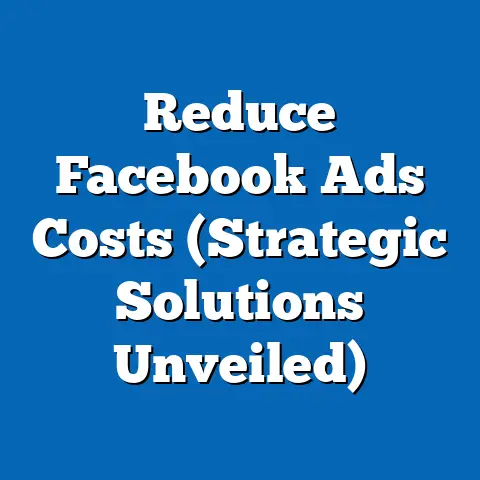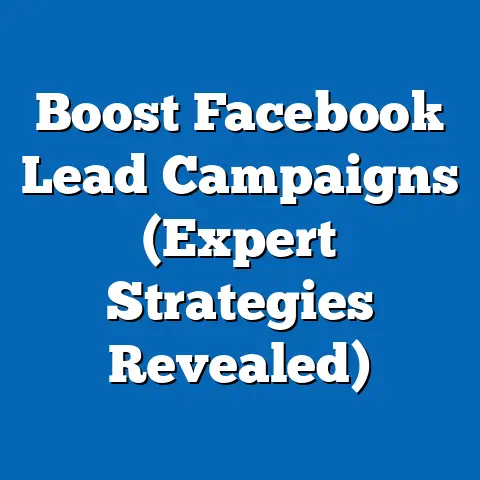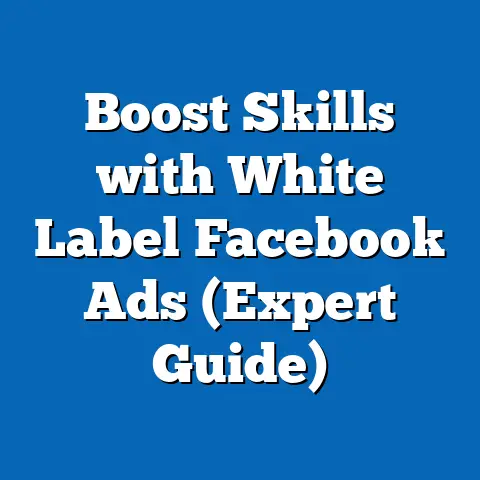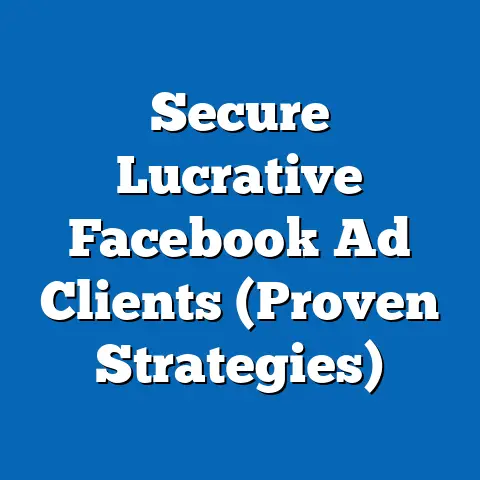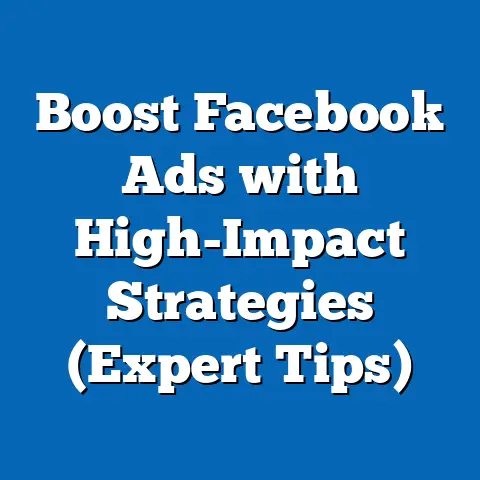Discover Affordable Facebook Ads Markets (Cost-Effective Strategies)
I’ve been there. Staring at the Facebook Ads Manager, feeling the weight of a marketing budget that seems to evaporate with every click. The initial excitement of reaching millions of potential customers quickly turns into frustration when the costs start to climb, and the ROI remains stubbornly low. It’s a story I hear all too often from small business owners and marketers: the dream of Facebook advertising turning into a nightmare of wasted spend and unmet expectations.
The truth is, navigating the ever-changing landscape of Facebook ads can feel overwhelming. The platform is a powerhouse, no doubt, but its complexity can be a significant barrier to entry, especially when budgets are tight. Many potential advertisers are deterred, believing that only those with deep pockets can truly succeed.
But what if I told you that success on Facebook doesn’t always require a massive budget? What if I showed you how to uncover hidden gems – affordable markets and cost-effective strategies – that can unlock the platform’s potential without breaking the bank? That’s exactly what I’m here to do. This guide is your roadmap to navigating the world of Facebook advertising on a budget, turning that initial frustration into a story of success and sustainable growth.
The Landscape of Facebook Advertising
Before diving into the specifics of affordable markets, let’s take a step back and understand the sheer scale and potential of Facebook’s advertising ecosystem.
Facebook isn’t just a social media platform; it’s a data goldmine. With over 2.91 billion monthly active users as of early 2023, it offers unparalleled reach. Think about it: that’s nearly 40% of the world’s population, all accessible through a single advertising platform.
But it’s not just about the numbers. What makes Facebook advertising truly powerful is its granular targeting capabilities. I’m constantly amazed by the level of detail you can achieve. You can target users based on:
- Demographics: Age, gender, location, education, relationship status, and more.
- Interests: Hobbies, activities, pages they’ve liked, and content they’ve engaged with.
- Behaviors: Purchase history, device usage, travel habits, and online activity.
- Connections: People who like your page, their friends, or those connected to your app.
This level of precision allows you to laser-focus your ads on the people most likely to be interested in your products or services, maximizing your ROI. For example, if I’m selling organic dog treats, I can target dog owners in my local area who are interested in natural pet food and have a history of purchasing pet products online.
However, this power comes with a responsibility: understanding the platform’s nuances. Facebook’s algorithm is constantly evolving, and what worked last year (or even last month) might not work today. Staying informed about the latest updates, best practices, and emerging trends is crucial for long-term success.
The Cost Dilemma
Despite its potential, Facebook advertising is often perceived as expensive, especially for small businesses with limited budgets. There are several reasons for this perception:
- Competition for Ad Space: With millions of businesses vying for attention on the platform, competition for ad space is fierce. This drives up the cost of impressions and clicks, making it more challenging to achieve a positive ROI. I’ve seen firsthand how crowded certain niches can become, with ad costs skyrocketing during peak seasons like the holidays.
- Bidding Strategies: Facebook uses an auction-based system to determine which ads are shown to users. Your bidding strategy plays a significant role in determining your ad costs. If you’re using a broad bidding strategy and targeting a highly competitive audience, you’re likely to pay more.
- Poor Targeting: One of the biggest mistakes I see businesses make is failing to properly define their target audience. Broad targeting leads to wasted impressions and clicks, as your ads are shown to people who are unlikely to be interested in your products or services.
- Low-Quality Ad Creatives: If your ads are visually unappealing, poorly written, or irrelevant to your target audience, they’re unlikely to generate engagement. This results in a lower Quality Score, which can increase your ad costs.
- Lack of Optimization: Facebook advertising is not a “set it and forget it” strategy. You need to constantly monitor your ad performance, make adjustments, and optimize your campaigns to achieve the best results. Failing to do so can lead to wasted spend and a poor ROI.
I remember working with a local bakery that was struggling with their Facebook ad campaign. They were targeting a broad audience in their city, using generic ad creatives, and not tracking their results. As a result, they were spending a significant amount of money with little to show for it. By narrowing their target audience to people interested in baking, using mouthwatering images of their products, and tracking their conversions, we were able to significantly improve their ROI.
It’s important to remember that Facebook advertising is an investment, not an expense. With the right strategy, targeting, and creatives, you can achieve a positive ROI and drive significant growth for your business. But it requires careful planning, execution, and ongoing optimization.
Identifying Affordable Markets
The key to unlocking affordable Facebook advertising lies in identifying markets that are often overlooked by larger advertisers. These markets may be smaller, more niche, or less competitive, but they can offer significant opportunities for businesses on a budget.
Here are some examples of affordable markets:
- Local Markets: Targeting a specific geographic area can be a cost-effective way to reach potential customers in your community. This is especially effective for businesses that offer local services or products. I’ve seen businesses achieve impressive results by targeting specific neighborhoods or zip codes with highly relevant ads.
- Niche Markets: Focusing on a specific niche market allows you to tailor your ads to a highly engaged and receptive audience. This can lead to higher click-through rates and conversion rates, reducing your overall ad costs. For example, instead of targeting “fitness enthusiasts,” you could target “yoga enthusiasts” or “crossfit enthusiasts.”
- Untapped Demographics: Consider targeting demographic groups that are often overlooked by other advertisers. This could include older adults, students, or specific ethnic communities. By identifying and targeting these untapped demographics, you can reach a highly valuable audience at a lower cost.
- Interest-Based Targeting: Facebook’s interest-based targeting allows you to reach users based on their hobbies, activities, and passions. By identifying interests that are less competitive, you can reach a highly engaged audience at a lower cost.
- Behavioral Targeting: Facebook’s behavioral targeting allows you to reach users based on their purchase history, device usage, and online activity. By identifying behaviors that are less competitive, you can reach a highly valuable audience at a lower cost.
The key is to think outside the box and identify markets that are underserved or less competitive. This requires research, experimentation, and a willingness to challenge conventional wisdom.
I once worked with a small online retailer that sold handmade jewelry. They were struggling to compete with larger jewelry retailers on Facebook. By focusing on a niche market – “bridesmaids jewelry” – and creating highly targeted ads, they were able to significantly improve their ROI and drive sales.
Cost-Effective Strategies for Facebook Ads
Once you’ve identified an affordable market, you need to implement cost-effective strategies to maximize your advertising budget. Here are some proven techniques:
Targeting Smaller Audiences
One of the most effective ways to reduce your Facebook ad costs is to narrow down your target audience. Instead of targeting a broad demographic group, focus on a smaller, more specific audience that is more likely to be interested in your products or services.
For example, instead of targeting “women aged 25-45,” you could target “women aged 25-45 who are interested in yoga and live in San Francisco.” This will significantly reduce the number of people you’re targeting, but it will also increase the likelihood that those people will be interested in your ads.
I’ve found that the more specific you can get with your targeting, the better your results will be. Don’t be afraid to experiment with different targeting options to find the sweet spot.
Utilizing Lookalike Audiences
Lookalike audiences are a powerful tool for expanding your reach while maintaining a high level of relevance. They allow you to create a new audience that is similar to your existing customer base, website visitors, or email subscribers.
Facebook uses its algorithm to identify the common characteristics of your existing audience and then finds new users who share those characteristics. This is a highly effective way to reach potential customers who are likely to be interested in your products or services.
I’ve seen lookalike audiences outperform traditional targeting methods in many cases. They’re a great way to scale your campaigns without sacrificing relevance or increasing your ad costs.
Optimizing Ad Placement
Facebook offers a variety of ad placements, including:
- Facebook Feed: Ads that appear in users’ news feeds.
- Instagram Feed: Ads that appear in users’ Instagram feeds.
- Facebook Right Column: Ads that appear in the right column of the Facebook website.
- Instagram Explore: Ads that appear in the Instagram Explore tab.
- Audience Network: Ads that appear on third-party websites and apps.
Each placement has its own advantages and disadvantages. Some placements are more expensive than others, and some are more effective for certain types of ads.
It’s important to experiment with different placements to see which ones work best for your business. I’ve found that the Facebook and Instagram feeds are generally the most effective placements, but it depends on your target audience and the type of ads you’re running.
Leveraging Retargeting Campaigns
Retargeting is a highly effective strategy for converting website visitors who didn’t make a purchase or take another desired action. By showing ads to people who have already interacted with your website, you can remind them of your products or services and encourage them to convert.
Retargeting campaigns are typically more cost-effective than traditional campaigns because you’re targeting people who are already familiar with your brand. They’re also more likely to convert because they’ve already shown an interest in what you have to offer.
I always recommend that businesses implement retargeting campaigns as part of their overall Facebook advertising strategy. They’re a great way to maximize your ROI and drive conversions.
Creative Approaches to Content
High-quality, engaging content is essential for success on Facebook. Your ads need to capture attention, resonate with your target audience, and inspire them to take action.
Here are some tips for creating effective Facebook ad creatives:
- Use High-Quality Visuals: Your ads should feature visually appealing images or videos that capture attention and convey your message.
- Write Compelling Copy: Your ad copy should be clear, concise, and persuasive. Highlight the benefits of your products or services and include a strong call to action.
- Target the Right Audience: Make sure your ads are relevant to your target audience. Use Facebook’s targeting options to reach the people who are most likely to be interested in your products or services.
- Test Different Creatives: Experiment with different ad creatives to see which ones perform best. Try different images, videos, and copy variations to find the winning combination.
- Tell a Story: Connect with your audience on an emotional level by telling a story that resonates with them. This can help you build trust and create a lasting impression.
I’ve seen firsthand how creative content can significantly improve the performance of Facebook ad campaigns. Don’t be afraid to experiment with different approaches to find what works best for your business.
For example, I worked with a local coffee shop that was struggling to attract new customers. We created a series of video ads that showcased the coffee shop’s cozy atmosphere, friendly staff, and delicious coffee. The ads were targeted to people in the local area who were interested in coffee and cafes. As a result, the coffee shop saw a significant increase in foot traffic and sales.
Budget Management Techniques
Effective budget management is crucial for maximizing your ROI on Facebook. Here are some tips for setting and managing your budget:
- Start Small: Don’t start with a large budget. Begin with a small budget and gradually increase it as you see results.
- Set a Daily Budget: Set a daily budget for each of your ad campaigns. This will help you control your spending and prevent you from overspending.
- Monitor Your Performance: Regularly monitor your ad performance and make adjustments as needed. Pay attention to metrics like click-through rate, conversion rate, and cost per acquisition.
- Adjust Your Bids: Experiment with different bidding strategies to see which ones work best for your business. You can use automatic bidding or manual bidding.
- Pause Underperforming Ads: If an ad is not performing well, pause it and try a different approach. Don’t waste money on ads that are not generating results.
- Use Budget Pacing: Facebook’s budget pacing feature helps you distribute your budget evenly throughout the day or week. This can prevent you from spending your entire budget in the first few hours of the day.
I always recommend that businesses carefully track their spending and monitor their ROI. This will help you make informed decisions about your budget and ensure that you’re getting the most out of your Facebook advertising campaigns.
Case Studies
Let’s take a look at some real-world examples of small businesses that have successfully utilized affordable Facebook ads markets and cost-effective strategies:
- Local Bookstore: A local bookstore targeted book lovers in their community with ads promoting author events and new releases. By focusing on a specific geographic area and using highly targeted ads, they were able to increase foot traffic and sales.
- Online Clothing Boutique: An online clothing boutique targeted women who were interested in fashion and style. They used lookalike audiences to expand their reach and retargeting campaigns to convert website visitors who didn’t make a purchase. As a result, they saw a significant increase in online sales.
- Mobile App Developer: A mobile app developer targeted users who were interested in productivity and organization. They created a series of video ads that showcased the app’s features and benefits. By using creative content and targeting a specific audience, they were able to increase app downloads and user engagement.
- Landscaping Company: A landscaping company focused on homeowners in affluent neighborhoods with ads showcasing their design expertise and lawn care services. They used before-and-after photos to demonstrate the quality of their work. By targeting a specific demographic and using compelling visuals, they were able to generate leads and win new clients.
- Catering Service: A catering service targeted event planners and businesses with ads promoting their services for weddings, corporate events, and parties. They offered a free consultation to encourage leads. By targeting a niche market and offering a valuable incentive, they were able to increase bookings and revenue.
These case studies demonstrate that success on Facebook doesn’t always require a massive budget. By identifying affordable markets, implementing cost-effective strategies, and creating high-quality content, businesses of all sizes can achieve a positive ROI.
Future Trends in Facebook Advertising
The world of Facebook advertising is constantly evolving. It’s important to stay informed about the latest trends and emerging technologies to stay ahead of the curve.
Here are some future trends to watch:
- Artificial Intelligence (AI): AI is already playing a significant role in Facebook advertising, and its influence is only going to grow. AI-powered tools can help you automate tasks, optimize your campaigns, and improve your targeting.
- Augmented Reality (AR): AR is becoming increasingly popular, and Facebook is investing heavily in this technology. AR ads allow users to interact with your products in a virtual environment, creating a more immersive and engaging experience.
- Video Advertising: Video is the most engaging type of content on Facebook, and it’s only going to become more important in the future. Businesses that invest in video advertising will be well-positioned to succeed on the platform.
- Personalized Advertising: Consumers are demanding more personalized experiences, and Facebook is responding by offering more advanced targeting options. Businesses that can personalize their ads to individual users will be more likely to capture their attention and drive conversions.
- Privacy Concerns: As concerns about data privacy continue to grow, Facebook is likely to implement stricter regulations on data collection and targeting. Businesses will need to adapt to these changes and find new ways to reach their target audience.
By staying informed about these trends, you can adapt your Facebook advertising strategy to stay ahead of the competition and maximize your ROI.
Conclusion
While Facebook advertising can be perceived as costly, I hope I’ve shown you that it doesn’t have to be. By identifying affordable markets, implementing cost-effective strategies, and creating high-quality content, businesses of all sizes can achieve a positive ROI.
The key is to shift your mindset and explore innovative approaches. Don’t be afraid to experiment, test new ideas, and challenge conventional wisdom. With the right strategy, you can unlock the power of Facebook advertising and drive significant growth for your business.
Remember, success on Facebook is not about having the biggest budget. It’s about having the smartest strategy.
Call to Action
Now it’s your turn! I’d love to hear about your experiences with Facebook advertising. What challenges have you faced? What strategies have worked for you? Share your thoughts and insights in the comments below.
And if you’re looking for more resources to help you on your Facebook advertising journey, be sure to check out my other articles and guides. Together, we can unlock the full potential of Facebook advertising and achieve sustainable growth for our businesses.

